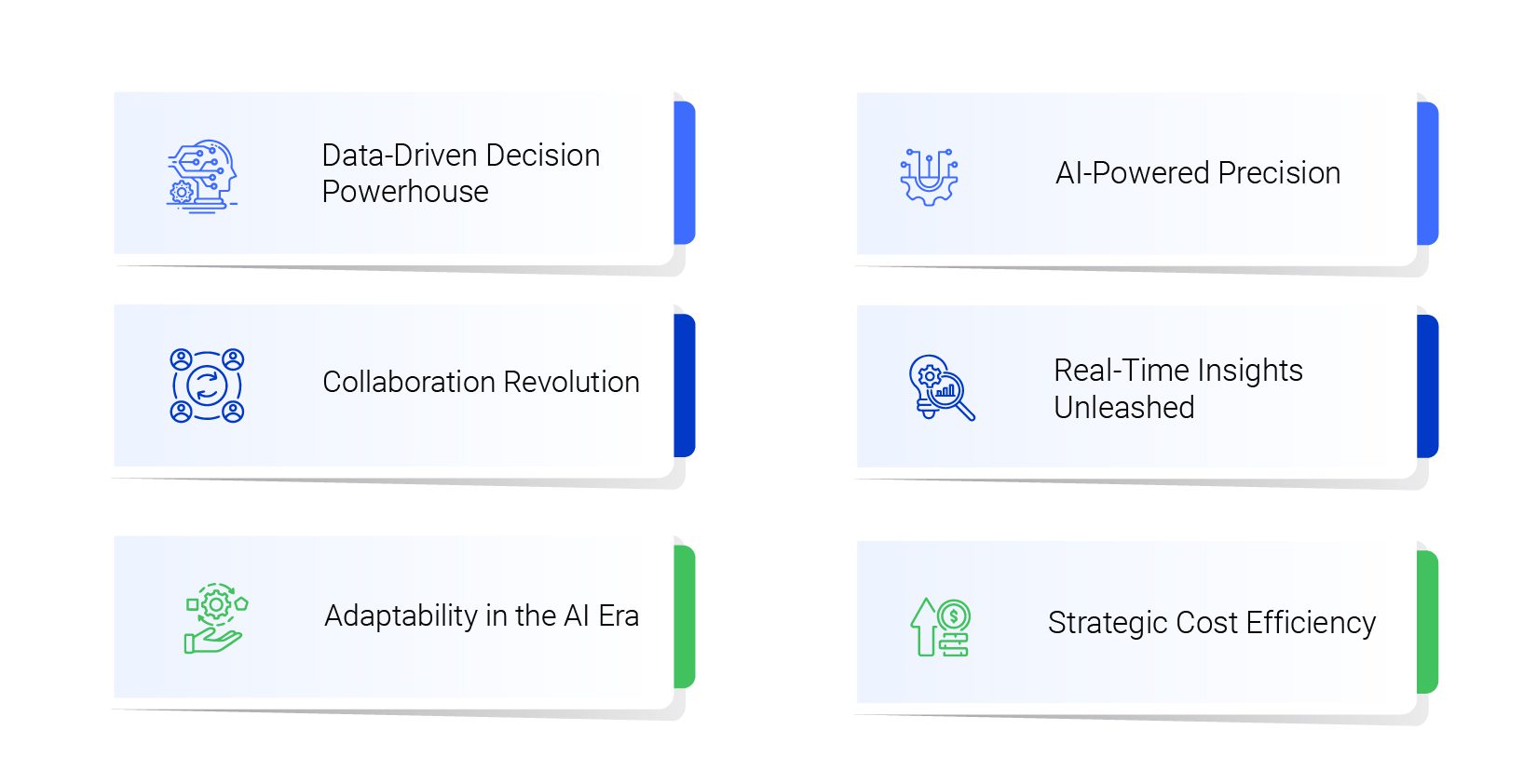Highlights:
- In 2023, the manufacturing industry witnessed a transformative shift with the integration of Industry 4.0, combining automation, IoT, and AI to enhance operational efficiency in smart factories.
- The year 2024 is poised for deeper AI integration, the evolution of smart factories, increased focus on sustainability, and the pivotal role of cloud-based Product Lifecycle Management (cPLM) systems in shaping the industry’s future.
- According to a recent survey by IDC, 70% of manufacturers are considering or planning to adopt cPLM in the next two years.
- Microsoft’s vision for cloud-based PLM marks a paradigm shift, emphasizing adaptability, innovation, and efficiency. Collaborating on the Azure File Migration Program, Microsoft and Data Dynamics offer a cost-free data migration solution for intelligent Azure adoption, accelerating innovation with cPLM.
In this Quick Byte:
As we wave goodbye to 2023, it’s worth noting the seismic shift in the manufacturing industry, driven by the convergence of technological advancements, a heightened focus on sustainability, and the integration of artificial intelligence (AI). Industry 4.0 took center stage, ushering in an era where smart factories seamlessly harnessed automation, the Internet of Things (IoT), and AI to elevate operational efficiency. The infusion of AI-driven analytics revolutionized manufacturing processes, while cloud adoption emerged as a strategic imperative, providing the agility needed for sustained growth. Now, as we look ahead to 2024, the manufacturing landscape is poised for even more profound changes. The integration of AI is set to deepen, smart factories will evolve further, sustainability initiatives will gain momentum, and cloud-based Product Lifecycle Management (cPLM) systems will play a pivotal role in shaping the industry’s future. In this blog, we explore the intersection of AI and cloud-based PLM, unraveling their impact on manufacturing processes and innovation. Additionally, we delve into Microsoft’s approach for cPLM, marking a paradigm shift in manufacturing, where collaboration, intelligence, and cloud-native solutions converge to redefine industry standards. Let’s dive into the space where data, collaboration, adaptability, precision, real-time insights, and cost efficiency come together to redefine possibilities in the dynamic landscape of AI-driven manufacturing.
Manufacturing: 2023 Recap and 2024 Preview
Looking back at the year 2023, the world of manufacturing experienced a significant overhaul, marked by the intersection of technological progress, a growing emphasis on sustainability, and the integration of artificial intelligence (AI). The advent of Industry 4.0 played a pivotal role, as smart factories harnessed the power of automation, the Internet of Things (IoT), and AI to boost operational efficiency and flexibility. The infusion of AI-driven analytics into manufacturing processes ushered in a new era of effectiveness and creativity. Simultaneously, cloud adoption emerged as a strategic imperative, providing the agility and scalability required for sustained growth. According to a survey conducted by McKinsey & Company, 65% of manufacturing executives considered cloud technology crucial for achieving their strategic priorities. Sustainability took center stage, with manufacturers prioritizing eco-friendly practices, circular economy principles, and reducing carbon footprints facilitated by AI-driven analytics. The Global Manufacturing and Industrialisation Summit reported a 20% increase in the adoption of sustainable practices among manufacturing companies globally. The global supply chain recalibrated, emphasizing resilience and adaptability through AI-powered predictive analytics.
Fast-forwarding into the prospect of 2024, manufacturers are poised to witness an acceleration of trends shaping the industry landscape. The integration of artificial intelligence (AI) is expected to deepen, becoming even more ingrained in manufacturing processes. Smart factories will evolve further, leveraging advanced AI algorithms to optimize production schedules dynamically, minimize downtime, and enhance product quality through continuous learning systems. According to a forecast by the International Data Corporation (IDC), spending on AI in manufacturing is projected to grow by 22% annually, reaching $15.7 billion by 2024. Predictive maintenance, powered by AI, will become more sophisticated, enabling manufacturers to anticipate and address equipment issues before disruptions occur. A study by PwC estimates that predictive maintenance can reduce maintenance costs by up to 30% and downtime by 70%. Sustainability initiatives will continue gaining momentum, with manufacturers using AI-driven analytics to assess and refine their environmental impact. Circular economy principles will become more pervasive, with AI playing a pivotal role in designing sustainable product life cycles and minimizing waste. A report by the Ellen MacArthur Foundation indicates a 15% year-on-year increase in companies adopting circular economy practices. Supply chain resilience will remain a key focus, with manufacturers relying on AI-powered predictive analytics to proactively identify and mitigate potential disruptions, fostering an agile and adaptive supply network.
Collaborative robots, or cobots, will see expanded applications in manufacturing, working alongside human workers to enhance efficiency and productivity. According to the International Federation of Robotics, the global sales of industrial robots increased by 12% in 2023, with collaborative robots accounting for a significant portion of this growth. AI-driven quality control systems will evolve to deliver even higher precision, reducing defects and ensuring consistent product quality. Moreover, manufacturers will explore innovative use cases for AI, from designing personalized products to creating adaptive and flexible production lines that can swiftly respond to changing market demands.Amidst these transformative trends, cloud adoption will emerge as a necessity to keep pace with the rapid evolution of the industry. Cloud-based Product Lifecycle Management (PLM) systems will play a pivotal role, offering seamless collaboration and real-time access to critical data throughout the product lifecycle. According to a survey by Gartner, 80% of manufacturing organizations plan to increase their investment in cloud technology in the next two years. Embracing the synergy of AI and cloud technologies will not only redefine manufacturing paradigms but also position forward-thinking manufacturers for sustained success in the dynamic industry landscape.
What is Cloud-based Product Lifecycle Management?
Cloud-based Product Lifecycle Management (cPLM) stands as a revolutionary software solution, serving as a centralized hub for overseeing the complete product lifecycle, spanning from initial ideation to manufacturing and beyond. Leveraging the accessibility of cloud servers, cPLM breaks geographical barriers, allowing users worldwide to seamlessly access the platform with just an internet connection, eliminating the necessity for costly on-premises hardware and software setups. This shift to cPLM heralds a multitude of advantages over traditional on-premises PLM systems. Firstly, it significantly slashes costs, negating the need for upfront investments in infrastructure, as cPLM typically operates on subscription-based pricing models, aiding manufacturers in effective budgeting. Furthermore, its cloud-based nature liberates companies from the burdens of installation and maintenance, enabling IT resources to focus on strategic initiatives. Designed with scalability at its core, cPLM effortlessly adapts to the evolving demands of a growing business—an attribute often challenging and costly to achieve with conventional on-premises PLM systems. Its centralized platform fosters improved collaboration among teams, facilitating streamlined product development and manufacturing processes. Adding to its arsenal, cPLM provides real-time visibility into these processes, empowering early identification and resolution of potential issues. Lastly, the robust security protocols offered by cloud providers ensure the safeguarding of sensitive product data, shielding it from unauthorized access.
As a result of these benefits, cPLM is gaining traction among manufacturers of all sizes. According to a recent survey by IDC, 70% of manufacturers are considering or planning to adopt cPLM in the next two years.
Now, let’s explore how Cloud-based Product Lifecycle Management (PLM) intersects with Artificial Intelligence (AI), reshaping manufacturing processes and driving innovation:

- Data-Driven Decision Powerhouse: Cloud-based PLM systems act as a nerve center for manufacturing data, creating a unified data repository using cloud storage, leveraging machine learning models for comprehensive data analysis that becomes the lifeblood of AI algorithms. By ensuring all stakeholders access accurate and comprehensive data, these platforms pave the way for AI to make data-driven decisions that transcend traditional manufacturing constraints. As highlighted by a McKinsey report stating that data-driven organizations are 23 times more likely to acquire customers and six times more likely to retain customers.
- Collaboration Revolution: Picture engineers, designers, and manufacturers seamlessly collaborating in real-time, breaking down silos that often stifle innovation. Cloud-based PLM employs collaborative tools and APIs, enabling real-time interactions among teams, and fostering an environment where diverse expertise converges, providing the dynamic foundation necessary for AI applications to thrive by incorporating varied insights into the development and execution of AI-driven solutions. A study by Deloitte found that companies with a collaborative culture are twice as likely to be profitable and outperform their peers.
- Adaptability in the AI Era: In the rapidly evolving landscape of AI, flexibility is non-negotiable. Cloud-based PLM platforms aren’t just adaptable; they’re the chameleons of the manufacturing world. To meet the demands of evolving AI integration, cPLM’s cloud infrastructure allows for dynamic scaling to ensure that the latest and greatest in AI technology seamlessly melds with existing manufacturing processes. A Forbes Insights survey reports that 90% of executives see AI as critical for their businesses, emphasizing the need for adaptable solutions.
- AI-Powered Precision: Cloud-based PLM systems aren’t just bystanders in the AI revolution; they are active enablers. By integrating AI algorithms and analytics tools within cPLM relies on APIs and secure data pipelines, these platforms infuse manufacturing processes with predictive and prescriptive capabilities. Imagine a factory that predicts maintenance needs, optimizes production workflows, and fine-tunes quality control—all thanks to the marriage of PLM and AI. According to Accenture, AI in manufacturing can increase labor productivity by up to 40%.
- Real-Time Insights Unleashed: Gone are the days of reactive decision-making. Cloud-based PLM ensures real-time data processing through edge computing and distributed data architecture, enabling AI algorithms to analyze streaming data for immediate insights. From identifying potential bottlenecks to predicting maintenance requirements, these platforms empower manufacturers with real-time insights that give them the edge in an industry where seconds matter. A PwC survey reveals that 67% of manufacturers believe that AI will have a significant impact on decision-making processes.
- Strategic Cost Efficiency: The AI and cloud-based PLM alliance isn’t just about innovation; it’s also about strategic cost efficiency. By eliminating the need for sprawling on-premises infrastructure, utilizing serverless computing, automatic scaling, and efficient resource allocation for strategic cost efficiency, these systems cut through the clutter, reducing maintenance costs and freeing up resources for what truly matters—driving innovation in manufacturing. A study by Nucleus Research found that cloud applications deliver 2.1 times the return on investment (ROI) of on-premises applications.
The synergy between cloud-based PLM systems and AI isn’t a mere collaboration; it’s a revolution. It’s about creating a manufacturing ecosystem where data, collaboration, adaptability, precision, real-time insights, and cost efficiency converge to redefine what’s possible in the dynamic landscape of AI-driven manufacturing. Here are 5 real-life examples of companies that are utilizing Cloud-based Product Lifecycle Management in the manufacturing sector:
Siemens: Siemens, a global leader in industrial technology, has adopted cPLM to accelerate its innovation efforts. The company’s cPLM solution provides a collaborative platform for engineers to share ideas, explore new design concepts, and conduct simulations. As a result, Siemens has been able to reduce innovation cycles by 30% and increase the number of new product introductions by 25%.
Airbus: Airbus, a global leader in aerospace manufacturing, has adopted cPLM to streamline its complex product development processes. The company’s cPLM solution provides a single source of truth for product data, enabling engineers to collaborate effectively across different disciplines and locations. As a result, Airbus has been able to reduce development time by 20% and improve product quality by 15%.
Unilever: Unilever, a global consumer goods company, has implemented cPLM to improve its product quality and safety. The company’s cPLM solution provides a centralized platform for managing product data, including ingredients, formulations, and regulatory compliance. As a result, Unilever has been able to reduce product recalls by 50% and improve product safety by 20%.
Ford Motor Company: Ford Motor Company, a renowned automotive manufacturer, has implemented cPLM to enhance its supply chain management capabilities. The company’s cPLM solution provides real-time visibility into supplier performance, enabling Ford to identify and address potential disruptions early on. As a result, Ford has been able to reduce supply chain lead times by 10% and improve inventory accuracy by 95%.
Schneider Electric: Implementing a cloud-based PLM strategy allowed Schneider Electric to integrate its product design and manufacturing data across global operations. This initiative boosted collaboration, minimized errors, and facilitated quicker decision-making in their product development endeavors.
Microsoft’s Vision for cPLM: A Paradigm Shift in Manufacturing
Microsoft’s vision for cloud-based PLM marks a paradigm shift in manufacturing, acknowledging the pivotal role of adaptability, innovation, and efficiency. Embracing a cloud-native approach, Microsoft ensures agility, scalability, and security, liberating manufacturers from costly on-premises infrastructure and enabling swift adaptation to evolving business needs. This heralds a new era in manufacturing, where collaboration, intelligence, and cloud-native solutions converge to redefine industry standards.
Democratizing Product Data: At the core of Microsoft’s vision lies the democratization of product data. By breaking down silos and making product data accessible and understandable to all stakeholders, Microsoft envisions a collaborative environment where engineers, designers, marketers, and supply chain partners can seamlessly share information, foster innovation, and accelerate product development cycles.
Intelligent Product Lifecycle Management: Intelligent PLM goes beyond mere data management; it leverages the power of artificial intelligence (AI) and machine learning (ML) to extract actionable insights from vast amounts of product data. By analyzing trends, identifying patterns, and predicting potential issues, intelligent cPLM empowers manufacturers to make informed decisions, optimize resource allocation, and proactively address challenges before they arise.
Cloud-Native cPLM: Microsoft’s commitment to cloud-native cPLM solutions ensures that manufacturers can reap the benefits of cloud computing, including enhanced agility, scalability, and security. Cloud-native cPLM eliminates the need for costly on-premises infrastructure, enabling manufacturers to quickly deploy and scale their cPLM systems to meet evolving business needs.
The Data Dynamics Advantage
Facilitating the transition to a modernized, cloud-based approach for Product Lifecycle Management (PLM) in manufacturing begins with the crucial step of data migration. Microsoft, in collaboration with Data Dynamics, introduces the Azure File Migration Program tailored for enterprises seeking a ZERO-cost migration of their manufacturing data to Azure. This collaboration addresses challenges such as manual processes and budget constraints that often impede cloud initiatives.
The Azure File Migration Program offers a transformative solution, enabling organizations to seamlessly migrate unstructured files and object storage data to Azure without incurring additional costs or migration license concerns. Employing a policy-based migration process, the solution not only reduces risks but also ensures granular control over access and file security, preserving the integrity of manufacturing data. Organizations can register their migration projects with Data Dynamics, initiating the smooth movement of manufacturing data to Azure promptly.
Beyond data migration, the collaboration between Microsoft and Data Dynamics emphasizes intelligent data management across On-Premise, Azure, and Hybrid Cloud environments, enhancing overall efficiency. Data Dynamics stands out with its Unified Data Management (UDM) software designed for intelligent, data-driven migration to Azure. Notably, the software’s petabyte-scale capability is specifically tailored for manufacturing operations across Azure File, Azure Netapp, Azure Blob, and OneDrive, distinguishing it from solutions geared toward smaller environments.
Data Dynamics prioritizes enhanced data compliance and security through its migration module, seamlessly integrated with Microsoft Information Protection and Azure Information Protection. Geo-specific migration adheres to data sovereignty regulations, ensuring compliance with regional data requirements. Importantly, Data Dynamics ensures that manufacturing data remains accessible and usable without unnecessary restrictions, avoiding data hostage situations.
With a focus on modern enterprise needs, Data Dynamics offers a unified platform for enterprise data management that scales seamlessly across hybrid, multi-cloud, and legacy environments. This approach eliminates data silos, enhances efficiency, and provides unparalleled flexibility and future-proofing for clients aligning with the evolving demands of the business landscape.
To learn more about how Data Dynamics can help you leverage cPLM within Azure, visit our website at www.datadynamicsinc.com/microsoft/. You can also contact us at solutions@datdyn.com or (713)-491-4298 or +44-(20)-45520800.






